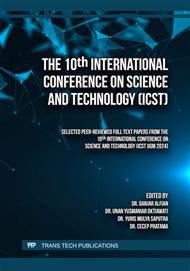[1]
J. Trienekens and P. Zuurbier, "Quality and safety standards in the food industry, developments and challenges," International Journal of Production Economics, vol. 113, no. 1, p.107–122, May 2008.
DOI: 10.1016/j.ijpe.2007.02.050
Google Scholar
[2]
A. Regattieri, M. Gamberi, and R. Manzini, "Traceability of food products: General framework and experimental evidence," Journal of Food Engineering, vol. 81, no. 2, p.347–356, Jul. 2007.
DOI: 10.1016/j.jfoodeng.2006.10.032
Google Scholar
[3]
M. M. Aung and Y. S. Chang, "Traceability in a food supply chain: Safety and quality perspectives," Food Control, vol. 39, p.172–184, May 2014.
DOI: 10.1016/j.foodcont.2013.11.007
Google Scholar
[4]
L. Wang, S. K. Kwok, and W. H. Ip, "A radio frequency identification and sensor-based system for the transportation of food," Journal of Food Engineering, vol. 101, no. 1, p.120–129, Nov. 2010.
DOI: 10.1016/j.jfoodeng.2010.06.020
Google Scholar
[5]
G. Alfian et al., "Improving efficiency of RFID-based traceability system for perishable food by utilizing IoT sensors and machine learning model," Food Control, vol. 110, p.107016, Apr. 2020.
DOI: 10.1016/j.foodcont.2019.107016
Google Scholar
[6]
E. Abad et al., "RFID smart tag for traceability and cold chain monitoring of foods: Demonstration in an intercontinental fresh fish logistic chain," Journal of Food Engineering, vol. 93, no. 4, p.394–399, Aug. 2009.
DOI: 10.1016/j.jfoodeng.2009.02.004
Google Scholar
[7]
Y. Bouzembrak, M. Klüche, A. Gavai, and H. J. P. Marvin, "Internet of Things in food safety: Literature review and a bibliometric analysis," Trends in Food Science & Technology, vol. 94, p.54–64, Dec. 2019.
DOI: 10.1016/j.tifs.2019.11.002
Google Scholar
[8]
M. M. Aung and Y. S. Chang, "Temperature management for the quality assurance of a perishable food supply chain," Food Control, vol. 40, p.198–207, Jun. 2014.
DOI: 10.1016/j.foodcont.2013.11.016
Google Scholar
[9]
M. Thakur and E. Forås, "EPCIS based online temperature monitoring and traceability in a cold meat chain," Computers and Electronics in Agriculture, vol. 117, p.22–30, Sep. 2015.
DOI: 10.1016/j.compag.2015.07.006
Google Scholar
[10]
G. Alfian, M. Syafrudin, and J. Rhee, "Real-Time Monitoring System Using Smartphone-Based Sensors and NoSQL Database for Perishable Supply Chain," Sustainability, vol. 9, no. 11, p.2073, Nov. 2017.
DOI: 10.3390/su9112073
Google Scholar
[11]
G. Aloi et al., "Enabling IoT interoperability through opportunistic smartphone-based mobile gateways," Journal of Network and Computer Applications, vol. 81, p.74–84, Mar. 2017.
DOI: 10.1016/j.jnca.2016.10.013
Google Scholar
[12]
S. Sharma, J. Raval, and B. Jagyasi, "Mobile sensing for agriculture activities detection," in 2013 IEEE Global Humanitarian Technology Conference (GHTC), San Jose, CA, USA: IEEE, Oct. 2013, p.337–342.
DOI: 10.1109/GHTC.2013.6713707
Google Scholar
[13]
P. Rajak, A. Ganguly, S. Adhikary, and S. Bhattacharya, "Internet of Things and smart sensors in agriculture: Scopes and challenges," Journal of Agriculture and Food Research, vol. 14, p.100776, Dec. 2023.
DOI: 10.1016/j.jafr.2023.100776
Google Scholar
[14]
V. Sathiya, K. Nagalakshmi, K. Raju, and R. Lavanya, "Tracking perishable foods in the supply chain using chain of things technology," Sci Rep, vol. 14, no. 1, p.21621, Sep. 2024.
DOI: 10.1038/s41598-024-72617-3
Google Scholar
[15]
K. Lin, D. Chavalarias, M. Panahi, T. Yeh, K. Takimoto, and M. Mizoguchi, "Mobile-based traceability system for sustainable food supply networks," Nat Food, vol. 1, no. 11, p.673–679, Nov. 2020.
DOI: 10.1038/s43016-020-00163-y
Google Scholar
[16]
J. Ahn, H. Gaza, J. Lee, H. Kim, and J. Byun, "Oliot EPCIS: An open-source EPCIS 2.0 system for supply chain transparency," SoftwareX, vol. 23, p.101477, Jul. 2023.
DOI: 10.1016/j.softx.2023.101477
Google Scholar
[17]
H.L. Gaza and J. Byun, "tracES++: Applying Incremental Computation to Temporal Information Diffusion Analysis for Online Object Traceability," IEEE Access, vol. 12, p.78811–78824, 2024.
DOI: 10.1109/ACCESS.2024.3394543
Google Scholar
[18]
"EPC C-1 G-2 / ISO 18000-6C RFID IC," EPC C-1 G-2 / ISO 18000-6C RFID IC. Accessed: Aug. 13, 2024. [Online]. Available: https://www.emmicroelectronic.com/sites/default/files/products/datasheets/4124-ds.pdf
DOI: 10.1109/rfid.2009.4911204
Google Scholar
[19]
"ARETE POP | tradekorea," ARETE POP | tradekorea. Accessed: Aug. 26, 2024. [Online]. Available: https://web.archive.org/web/20240902085556/https://tradekorea.com/product/ detail/P341461/ARETE-POP.html
Google Scholar
[20]
Y.-S. Kang, I.-H. Park, J. Rhee, and Y.-H. Lee, "MongoDB-Based Repository Design for IoT-Generated RFID/Sensor Big Data," IEEE Sensors J., vol. 16, no. 2, p.485–497, Jan. 2016.
DOI: 10.1109/JSEN.2015.2483499
Google Scholar
[21]
"Denshine® FTLAB FTC-001 SmartLab Smart Temperature Humidity Checker (Blue)," Denshine® FTLAB FTC-001 SmartLab Smart Temperature Humidity Checker (Blue). Accessed: Aug. 26, 2024. [Online]. Available: https://web.archive.org/web/20240902090016/ https://www.amazon.ca/Denshine%C2%AE-FTC-001-SmartLab-Temperature-Humidity/dp/B01D2XI4M2
Google Scholar
[22]
M. Syafrudin, N. Fitriyani, D. Li, G. Alfian, J. Rhee, and Y.-S. Kang, "An Open Source-Based Real-Time Data Processing Architecture Framework for Manufacturing Sustainability," Sustainability, vol. 9, no. 11, p.2139, Nov. 2017.
DOI: 10.3390/su9112139
Google Scholar
[23]
S.A. Ajila and D. Wu, "Empirical study of the effects of open source adoption on software development economics," Journal of Systems and Software, vol. 80, no. 9, p.1517–1529, Sep. 2007.
DOI: 10.1016/j.jss.2007.01.011
Google Scholar
[24]
K. Ven and J. Verelst, "The Organizational Adoption of Open Source Server Software by Belgian Organizations," in Open Source Systems, vol. 203, E. Damiani, B. Fitzgerald, W. Scacchi, M. Scotto, and G. Succi, Eds., in IFIP International Federation for Information Processing, vol. 203., Boston, MA: Springer US, 2006, p.111–122.
DOI: 10.1007/0-387-34226-5_11
Google Scholar


